
Tale of Hercules, based on Greek and Roman Mythology.
- Subject:
- History
- Science
- Social Studies
- Material Type:
- Reading
- Provider:
- EU-UNAWE Spain
- Provider Set:
- EU Universe Awareness
- Author:
- Paolo Capponi
- Date Added:
- 05/10/2018

Tale of Hercules, based on Greek and Roman Mythology.

The fact that no one knows the answer to this question is what makes it exciting. The story of physics has been one of an ever-expanding understanding of the sheer scale of reality, to the point where physicists are now postulating that there may be far more universes than just our own. Chris Anderson explores the thrilling implications of this idea. A quiz, thought provoking question, and links for further study are provided to create a lesson around the 5-minute video. Educators may use the platform to easily "Flip" or create their own lesson for use with their students of any age or level.

This NASA site hosts a composite image of the southern lights Aurora over the South Pole. A link enables visitors to view a video of this aurora. The image of the Aurora is overlaid on a NASA ‰ÛÏBlue Marble‰Û� image also captured by satellite. Text describes the distortion of Earth‰Ûªs magnetic field by the stream of protons and electrons from the sun.
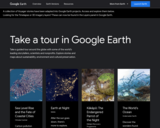
You can take a tour of 18 different scenes from the International Space Station with this Google Earth tour. Visit the Columbus Research Laboratory, SpaceX Dragon Docking Vehicle and more!
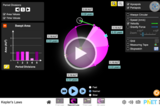
Embark on a celestial adventure as you delve into the intricate dance of planets, explore the profound implications of Kepler's Laws, and unravel the complex relationships between velocity, position, and orbital characteristics!
• Explore how the velocity and position of a planet affect its movement and orbit.
• Discover how Kepler’s Laws apply for different bodies in the solar system
• Describe the characteristics of an ellipse that support the understanding of planets’ orbits according to Kepler’s first law
• Visualize what is meant by “swept area of a planet’s orbit” and its relationship with equal time intervals in the context of Kepler’s second Law.
• Describe the behavior of the planet's velocity in different moments of its orbit
• Explore the relationship between the semi-major axis and the period of an orbit, and their corresponding powers described by the Kepler’s third Law

A story based on Inca stories of the sky about a llama.

This part of the Student Observation Network allows you to make observations to answer the question, "Have auroras been seen within the last 24 hours due to a solar storm?"
The Student Observation Network provides guided inquiry. While participating in the Auroral Friends program your students may think of other questions that they wish to investigate. For instance, they may wish to know; "What causes the aurora?", "What affect does a solar storm have on aurora?", and "What conditions enhance auroras?". These open inquiries may reveal to them that coronal holes may energize auroras even when solar storms have not occurred.

Students will examine a medieval manuscript on astronomy and create their own books based on modern discoveries in astronomy.

Can you avoid the boulder field and land safely, just before your fuel runs out, as Neil Armstrong did in 1969? Our version of this classic video game accurately simulates the real motion of the lunar lander with the correct mass, thrust, fuel consumption rate, and lunar gravity. The real lunar lander is very hard to control.

This is a booklet containing 37 space science mathematical problems, several of which use authentic science data. The problems involve math skills such as unit conversions, geometry, trigonometry, algebra, graph analysis, vectors, scientific notation, and many others. Learners will use mathematics to explore science topics related to Earth's magnetic field, space weather, the Sun, and other related concepts. This booklet can be found on the Space Math@NASA website.

Build a simple reflective telescope and learn about the use of its mirrors.

Build a simple refractory telescope.

Build a physical model of a black hole to help understand them.

A Cubeo Indian legend from the Amazon.
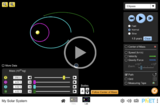
Embark on an exhilarating journey across the cosmos as you unravel the intricate dance of planets, delving into the profound effects of position, mass, velocity, and distance on their celestial motions and orbits!
• Predict how the position, mass, velocity, and distance between planetary bodies affect their motion and orbits.
• Illustrate how the gravitational force controls the motions of the planets.
• Explore the different motions that a group of planetary bodies can have.
• Describe the behavior of the planet's velocity in different moments of its orbit.
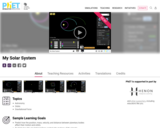
Build your own system of heavenly bodies and watch the gravitational ballet. With this orbit simulator, you can set initial positions, velocities, and masses of 2, 3, or 4 bodies, and then see them orbit each other.

" NASA stands for National Aeronautics and Space Administration. NASA is a U.S. government agency that is responsible for science and technology related to air and space."
Learn about space on this site. Explore Missions, Picture Galleries, Downloads etc. and learn about Humans in Space, Moon to Mars, Earth, Space Tech, Flight, Solar System and more.

The purpose of NASA's Earth Observatory is to provide a freely accessible publication on the Internet where the public can obtain new satellite imagery and scientific information about our home planet. The focus is on Earth's climate and environmental change. The site is divided into six main sections: Data and Images, Features, News, Reference, Missions, and Experiments. The Data and Images, Features, and Reference sections are each subdivided into sections for Atmosphere, Oceans, Land, Life on Earth, and Heat and Energy. The missions section explains all of the current NASA missions, and the Experiments section contains activities related to the topics covered in the other sections. Information provided in these pages includes text, photographs, animations, maps, and datasets. The site also includes a glossary, "ask a scientist" feature, and links to current news stories.

The purpose of NASA's Earth Observatory is to provide a freely-accessible publication on the Internet where the public can obtain new satellite imagery and scientific information about our home planet. The specific focus of this Earth Observatory website is natural hazards. Earth scientists around the world use NASA satellite imagery to better understand the causes and effects of natural hazards. The goal in sharing these images is to help people visualize where and when natural hazards occur, and to help mitigate their effects. Natural hazards that are emphasized include dust and smoke, wildfires, floods, severe storms, and volcanoes. In addition, each week the site highlights major natural hazard events occurring around the globe. Links to satellite imagery and informational text concerning the natural hazard and image interpretation are included. The site also offers a link to unique imagery, such as earthquakes, droughts, and landslides, and features the latest unique imagery events around the globe.
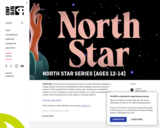
North Star chronicles the exceptional journey of Laurie Rousseau-Nepton, a young, Quebec-born Innu astrophysicist who’s leading a massive research project at the Canada-France-Hawaii Telescope. Drawing on a worldview rooted in a love of nature, as well as her talents as a science communicator, Laurie shares her passion for the study of celestial objects.